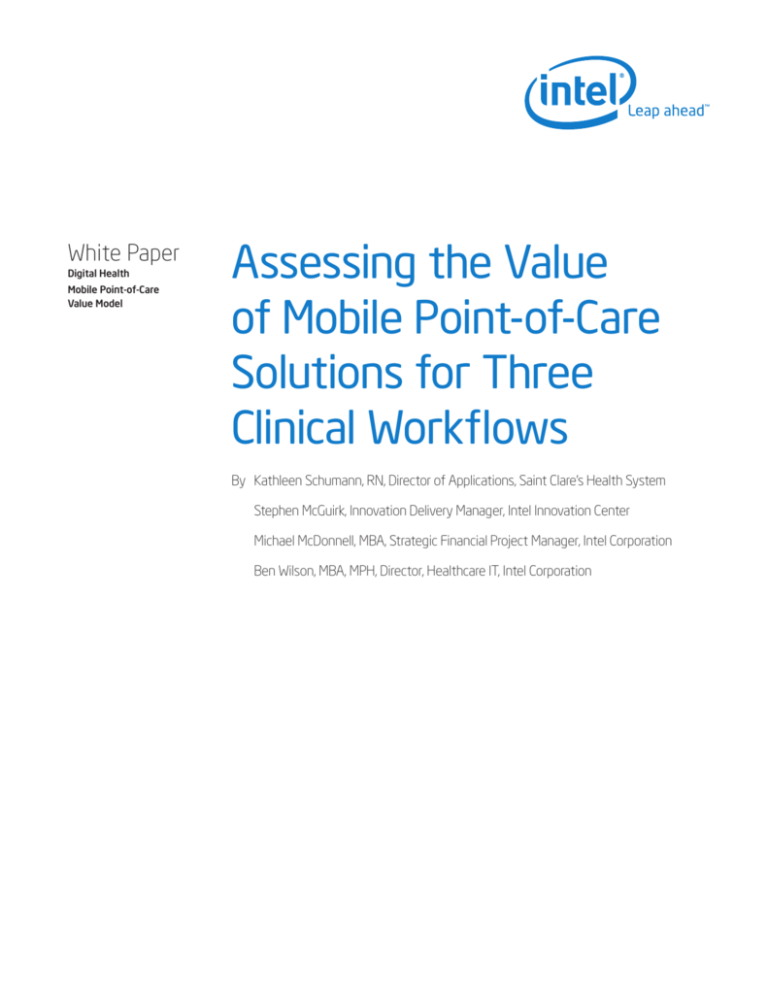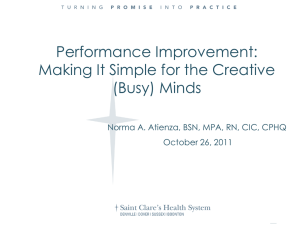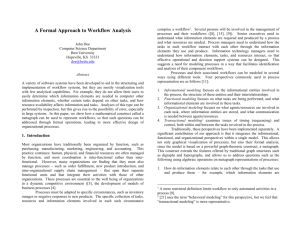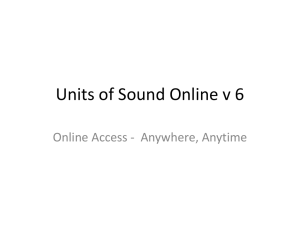
White Paper
Digital Health
Mobile Point-of-Care
Value Model
Assessing the Value
of Mobile Point-of-Care
Solutions for Three
Clinical Workflows
By Kathleen Schumann, RN, Director of Applications, Saint Clare’s Health System
Stephen McGuirk, Innovation Delivery Manager, Intel Innovation Center
Michael McDonnell, MBA, Strategic Financial Project Manager, Intel Corporation
Ben Wilson, MBA, MPH, Director, Healthcare IT, Intel Corporation
White Paper: Assessing the Value of Mobile Point-of-Care Solutions For Three Clinical Workflows
Executive Summary:
Streamlining Clinical Workflow
Saint Clare’s Health System used Intel’s mobile point-of-care (MPOC) value model in
a small-scale pilot to identify the business value of investing in MPOC solutions. Two
clinical workflows demonstrated broad and significant value from the use of MPOC
technologies: bedside charting by rounding respiratory therapists, and dictation of
progress notes and other clinical documentation by a select group of physicians who
were mandated to use dictation. Rehabilitation therapists had a more static workflow
and did not demonstrate business value from the MPOC solution.
The optimized workflows:
• Saved 55 minutes daily per respiratory therapist,
producing a 13 percent productivity increase
• Enhanced productivity for administrative staff
by 12 percent and for physicians by 2 percent
• Reduced the cost of certain external dictation
services by 52 percent
Analysis with the MPOC value model showed
that the increased productivity and reduction
in dictation costs would generate significant
monetary benefits. The pilot would save $51,000
annually prior to expenses, yielding a three-year
net present value (NPV) of $103,000. Largescale deployment would save over $347,000
annually prior to expenses (see Table 1), yielding
a three-year NPV of $619,000. Factoring in
• Improved records compliance by 22.5 points
expenses, payback would come within one year.
• Improved staff satisfaction with their tools
As a result of the pilot and the value model
by 20 percent
Positive impacts were also noted for quality
of care.
analysis, Saint Clare’s is moving rapidly—and
with greater confidence in the benefits to be
achieved—toward broader MPOC deployment.
Table 1. Annual Gross Savings
(Large-Scale Deployment)
2
Physician productivity
$56,965
Dictation expenses
$130,604
Administrative
productivity
$9,359
Respiratory therapist
productivity
$150,150
Total
$347,078
1. Net present value analysis brings forward all costs and savings, and values them in the present day, enabling
comparison of projects with different time scales.
White Paper: Assessing the Value of Mobile Point-of-Care Solutions For Three Clinical Workflows
Data-Driven Decisions to Enhance
Clinical Workflows
Would mobile technologies
help Saint Clare’s enhance
care? Would they be a
sound investment? What
workflows would benefit?
Saint Clare’s Health System is northwest New Jersey’s largest community health
system. A Catholic faith-based organization, Saint Clare’s provides compassionate,
high-quality care through four hospitals and healthcare facilities. It is a member of
Catholic Health Initiatives, a Denver-based ministry with health organizations in 19
states nationwide.
Beginning in November 2006, Saint Clare’s
A solution that relieved contention and offered
Health System successfully deployed a broad
greater mobility was clearly in order—but which
suite of Cerner Millennium* electronic medical
workflows would benefit? Would mobile
records (EMRs), including 17 healthcare
technologies actually help Saint Clare’s deliver
information technology (HIT) solutions, across
higher- quality, more cost-effective care? Would
all disciplines at its four New Jersey facilities.
MPOC technologies be a sound investment?
Since the initial rollout, Saint Clare’s physicians
and other staff have gone from pre-deployment
jitters and uncertainty, to enthusiastic
acceptance and growing awareness of the many
ways in which HIT can improve the quality, cost,
and accessibility of Saint Clare’s healthcare services.
With that awareness have come frequent
requests for added functionality, including
easier access to digital information at the point
and intuition. To take a more informed, datadriven approach, the Saint Clare’s leadership team
collaborated with Intel Corporation on a smallscale pilot to:
• Evaluate the use of mobile technologies in
three clinical workflows.
• Identify and measure the potential business
of care. Saint Clare’s had implemented wireless
value of investing in MPOC solutions for these
networking at all facilities, and provided access
workflows.
to digital information via stationary PCs and
wireless computers on wheels (WOWs). But space
and contention created ongoing headaches.
Theoretically, WOWs are mobile devices, but in
practice, they can be cumbersome to maneuver
through crowded hospital rooms and corridors.
As a result, many clinicians take handwritten
notes at the bedside for later entry into the
computer. This creates redundant work,
introduces transcription errors, and causes
delays in making information available to other
members of the care team. In addition, clinicians
often had to line up to access a PC, which
impacted productivity and satisfaction and
added further information latency.
3
Too often, such decisions are based on instinct
White Paper: Assessing the Value of Mobile Point-of-Care Solutions For Three Clinical Workflows
Identifying Business Value:
The Intel MPOC Value Model
Investments in MPOC
Saint Clare’s used Intel’s mobile point-of-care
As a starting point for discussion, the Intel model
solutions should improve
value model, a patent-pending tool designed
provides a set of key performance indicators
value dials such as quality of
to help healthcare organizations build a quick
(KPIs) for each value dial. KPIs are observable,
care, staff productivity, cost
business case for proposed MPOC investments
quantifiable, operational metrics that can be
optimization, and staff
without having to engage a finance expert and
used to measure meaningful changes. Additional
satisfaction.
carry out exhaustive ROI analysis. The value
value dials and KPIs can be established to suit
model can also be used to identify post-
institutional priorities.
deployment benefits.
To use the value model, relevant KPIs are
The value model is based on an approach that
established and a baseline of current performance
Intel developed to analyze its own IT investment
is measured for each indicator. After pilot or
strategies. Intel later used the model with a range
production deployment, changes are measured
of companies and organizations. More recently,
against the baseline, and the monetary impact
clinicians and financial analysts in Intel’s Digital
is established where possible. Even when
Health Group have collaborated with healthcare
institutions do not gather data on actual use,
leaders to adapt it to the needs of the healthcare
the discussions needed to identify hoped-for
industry. Intel offers a free, interactive tool, as
business value can be extremely fruitful
well as advisory services for organizations
in aligning IT purchases with important
wanting to conduct a customized analysis.
value drivers.
The value model starts from Intel’s core belief that
The model emphasizes quantifiable benefits
all IT investments must support strategic goals.
for which a financial impact can be determined,
Investments in mobile point-of-care technology
while acknowledging that investments in mobile
should improve value dials such as quality of care,
technologies can also produce many intangible
workflow optimization (staff productivity), cost
and important gains. Many performance
optimization, and staff satisfaction.
indicators can be applied to multiple value dials,
but for determining financial value, each KPI is
counted only once.
4
White Paper: Assessing the Value of Mobile Point-of-Care Solutions For Three Clinical Workflows
Respiratory therapists,
physicians, and rehabilitation
Pilot Overview
therapists were interviewed
and observed as they went
through their daily
routines—with and without
a technology-enabled
optimized workflow.
Saint Clare’s identified three clinical workflows as candidates for a mobile point-ofcare solution:
• Respiratory therapists. These clinicians
professionals in acute care settings. The MCA
conduct rounds to monitor patients with
provides a sure-grip handle for easy carrying, and
pulmonary difficulties and to administer inhaler
a sealed case that’s designed to be easy to wipe
and/or respiratory medication and treatments.
off with disinfectant and shock-resistant if
A mobile device might save time by enabling
dropped. The device also has built-in capabilities
them to do real-time charting at the bedside.
that add value in clinical settings, including a
• Physician dictation. Some physicians are
mandated to use an external dictation service
microphone, digital camera, and barcode or radio
frequency identification (RFID) reader.
to document their care. Voice recognition
Three physicians participated in the pilot, using
software might provide a more efficient and
Nuance* Dragon* NaturallySpeaking* Medical
economical alternative.
Edition software. Due to temporary technical
• Rehabilitation therapists. Rehabilitation
therapists deliver physiotherapy and other
care. They might be expected to see benefits
similar to those of respiratory therapists.
For the pilot, one respiratory therapist and one
rehabilitation therapist were equipped with an
innovative mobile device called the mobile clinical
assistant platform (MCA). Larger than a PDA
but smaller and lighter than an ordinary tablet
computer, the MCA (Figure 1.) was developed by
difficulties, they used ordinary tablets rather
than the MCA. However, the dictation workflow
would also be a candidate for the MCA once
those difficulties are resolved.
The pilot was conducted at Saint Clare’s Hospital,
Denville, New Jersey. Workshops were held to
identify key performance indicators that could be
affected, and to choose those for which it was
feasible to collect relevant data. Table 2 summarizes
the relevant values and KPIs for these workflows.
Intel’s Digital Health Group in collaboration with
Participating physicians and therapists were
clinicians to meet the unique needs of medical
interviewed and shadowed as they performed
their jobs, and workflows were modified to
incorporate the MPOC solution. Baseline data
(the “before” workflow without MPOC technologies)
was collected October 15—16, 2007. Participants
were trained on the use of the device and
software, and data on the MPOC-enabled
workflows was collected December 10—11.
Figure 1. A Mobile Clinical Assistant
5
White Paper: Assessing the Value of Mobile Point-of-Care Solutions For Three Clinical Workflows
Table 2. Relevant Value Dials and Key Performance Indicators for Saint Clare’s MPOC Pilot
Value Dials
Key Performance Indicators
Comments
Staff productivity
(via workflow
optimization)
Respiratory therapist time savings+
Time savings through eliminating
duplicate data entry and PC contention
Physician time savings+
Time savings on dialing the dictation
service, dictating, re-dictating, clearing
rejections, correcting records, etc.
Administrative staff time savings+
Health Information Center staff saved
time on dictation-related quality
assurance tasks
Increased compliance with regulatory
mandates
Avoidance of problems stemming from
lack of compliance
Reduction in time spent on
administrative tasks
Ability to spend more time on clinical
care
Reduced length of stay
Potential ability to improve clinical
decision making, leading to earlier
patient discharge through faster
information availability
Reduction in costs for dictation
services+
Avoidance of costs for dictation
services
Increases in charge capture
Improvements enabled by real-time
documentation
Increases in patient and staff
satisfaction
Improvements in the quality and
efficiency of care can enhance staff
satisfaction and potentially increase
staff retention.
Quality of care
Cost optimization
Patient/staff
satisfaction
Patients generally report greater
feelings of satisfaction as clinicians
spend more time at the bedside.
+
6
These indicators were measured and used to determine the solution’s business value.
White Paper: Assessing the Value of Mobile Point-of-Care Solutions For Three Clinical Workflows
Pilot Impact
The optimized workflow
Respiratory Therapy Workflow technology-enabled change allowed RTs to
saved respiratory therapists
Respiratory therapists (RTs) have a highly mobile
eliminate duplicate data entry and avoid the need
55 minutes per day per
workflow, and they achieved huge gains in
to search for a free PC. The time savings for any
therapist by eliminating
business value from the mobile point-of-care
given patient visit were small, but because RTs
duplicate tasks. The
solution. These therapists conduct patient visits
see numerous patients, the productivity gains
increased productivity
throughout the day, monitoring patients, reading
had large multiplier effects. Observations showed
delivered a daily financial
and charting data from clinical equipment, and
that eliminating duplicate data entry saved an
impact of $83 per therapist.
performing and documenting respiratory
impressive 55 minutes per therapist per shift.
treatments. The rooms of pulmonary patients are
often crowded with clinical equipment, so rather
than maneuvering a PC cart to the bedside, RTs in
the pre-pilot workflow made notes on paper and
entered them into a PC later.
With the MPOC solution, therapists used the
MCA to chart at the bedside (Figure 2). This
Figure 2. Changes to the Respiratory Therapy Workflow
7
In addition to saving time and steps, the
optimized workflow meant that status
information was entered into the EMR system
sooner. By making the data immediately available,
the MPOC solution thus enabled more informed
decision making.
White Paper: Assessing the Value of Mobile Point-of-Care Solutions For Three Clinical Workflows
The MPOC solution reduced
Physician Dictation Workflow
Physician Productivity
dictation costs and provided
Saint Clare’s has system wide dictation expenses
Physician benefits came from time savings
significant productivity gains
of over $600,000, with the Denville facility
enabled by mobility gains, as well as from the use
for the administrative staff
accounting for more than $300,000. A portion of
of the mobile devices rather than the dictation
managing patient records.
that cost comes from physicians who, for
service for dictation. Using a laptop PC, physicians
Physicians achieved a
legibility reasons, are mandated to dictate their
could dictate their notes anywhere—they didn’t
modest productivity gain
patient notes, including discharge summaries,
have to return to the nurse’s station to conduct
that should increase as the
progress notes, and consultation notes.
their dictation.
In the pre-pilot workflow, these physicians
In reality, since many Saint Clare’s processes
captured notes on paper or in memory as they
are still paper-based, physicians still returned
conducted rounds, returning to phones at the
to the nurse’s station for other tasks, so this
nurses’ station to call into an external dictation
productivity gain was a modest but significant
service. The hospital paid a premium for two-hour
2 percent. Physician productivity savings are
turnaround, and the transcribed notes were
expected to grow as more processes become
generally returned well within the two-hour limit.
fully electronic. Meanwhile, the laptops gave
Often, however, there were significant gaps in
physicians the freedom to input data and view
the information.
patient record details in the cafeteria, doctor’s
environment becomes more
fully electronic.
lounge, or other locations in and outside of
With the MPOC solution, physicians dictated their
the hospital.
notes directly into voice recognition software on
a laptop PC. This change created business value
in a variety of ways.
Physician Workflows
Post
Pre
1
1
Pre
Data input / Dictate / Move
on to next patient or ward
Post
Ward
2
2
2
2
Room
3
1
1
3
4
3
4
4
5
5
Room
4
5
6
6
6
7
7
8
9
7
Finished
8
Room
9
Finished
Room
Nurses Station
PC's
Desk Phones
5
7
6
Elapsed
time
Figure 3. Changes to the Physician Dictation Workflow
8
Time saved increases
without constant need
to return to station
White Paper: Assessing the Value of Mobile Point-of-Care Solutions For Three Clinical Workflows
Quality of Care
captured by the Nuance Dragon medical
The MPOC solution had several indirect impacts
dictionary. In addition, physicians could monitor
on clinical outcomes. The productivity savings
the transcription as it took place and immediately
enabled physicians to increase the time spent on
repeat words or phrases that were not captured
clinical tasks. The ability to document progress
correctly. This increased the overall quality of
notes immediately, rather than relying on memory
clinical data.
and handwritten notes, can also improve the
Compliance with Joint Commission guidelines
quality and timeliness of clinical information,
which in turn can indirectly affect quality of care.
is an indicator of high-quality care. Lack of
compliance can have clear cost implications,
In some cases, dictation transcribers were not
as well as influence a hospital’s prestige and
able to capture all data spoken by physicians. This
reputation. The voice recognition solution on
produced “blanks” in the transcription where
mobile technologies improved the ability of Saint
speech was not clearly understood. Saint Clare’s
Clare’s to conform to Joint Commission guidelines
physicians reported that they were impressed
on dictation by an average of 22 points (Table 3).
with the quality of medical language data
Table 3. Change in Regulatory Compliance
Compliance Aspect
Pre-Pilot
Pilot
Improvement
Unapproved abbreviations
99%
100%
1%
Date/time entry recorded
83%
100%
17%
Corrections made as needed
29%
100%
61%
Progress note legibility
89%
100%
11%
Administrative Staff Productivity
pilot reinforced the importance of matching the
Administrative personnel in Saint Clare’s Health
technology to the workflow. Rehabilitation
Information Center (HIC) are responsible for
therapists loved the MCA, but their workflow is
managing patient records and ensuring
relatively static and did not in fact benefit from
compliance with Joint Commission guidelines. This
the use of an MPOC solution.
includes verifying patient numbers, clearing
rejected dictations, and obtaining time stamps
and physician signatures if those are required but
were not provided.
In contrast to respiratory therapists, who conduct
rounds and see large numbers of patients,
rehabilitation therapists see patients in the
therapists’ rooms for treatment, and they see
The MPOC-enabled dictation solution enhanced
fewer patients in a day. In addition, rehabilitation
HIC staff productivity 1 percent in the pilot as a
therapists do not administer medications, so
result of the higher quality of data and a reduction
there is less risk from delays in charting. Since so
in rework. This figure would scale to a very
much of rehabilitation therapy is hands-on,
significant 12 percent on large-scale deployment.
therapists tended to put the MCA aside while
they interacted with patients, thus losing the
Cost Optimization
benefits of a device that enabled face-to-face
Pilot results indicated a drop in dictation expenses
conversation and charting.
of 4 percent from the use of the mobile solution,
rising to 52 percent on large-scale deployment.
Rehabilitation Therapist Workflow
9
The rehabilitation therapists’ experience in the
In short, the MPOC solution produced minimal
changes in the rehabilitation workflow and had
little impact on the business value dials. The
impact of these changes was not formally
analyzed or included in the analysis.
White Paper: Assessing the Value of Mobile Point-of-Care Solutions For Three Clinical Workflows
Business Value Summary
The pilot team used the Intel mobile point-of-care value model to determine the
solution’s business value based on four key performance indicators: productivity
increases for respiratory therapists, physicians, and Health Information Center staff;
and cost optimization on the dictation service. Based on the pilot results, the pilot
team extrapolated the results of full-scale deployment. Figure 4 summarizes the
identified business value.
Figure 4. Business Value Summary
10
White Paper: Assessing the Value of Mobile Point-of-Care Solutions For Three Clinical Workflows
Net present value analysis showed a value of
forward all costs and savings and values them in
$57,000 without dictation and nearly $103,000
the present day, enabling comparison between
with dictation. NPV for the large-scale deployment
projects of different time scales. The analysis used
was nearly $619,000. (See Table 4.) Net present
a 12 percent hurdle rate (minimum rate of return)
value analysis was used because it can account for
over a three-year period, and all productivity
recurring maintenance and support costs as well
savings were cut in half to guard against
as the initial investment. NPV analysis brings
overstating the expected benefits.
Table 4. Net Present Value Analysis
Scenario
11
Annual Gross
Benefit
Initial
Investment
Average Annual
Ongoing Expense
3-Year Net
Present Value
Pilot—no dictation
$30,030
$8,394
$5,516
$57,013
Pilot with dictation
$50,802
$11,379
$5,516
$102,722
Large-scale deployment
$347,078
$114,440
$79,263
$618,800
White Paper: Assessing the Value of Mobile Point-of-Care Solutions For Three Clinical Workflows
Further Gains
Saint Clare’s Health System is moving forward with MCA and MPOC deployment, and
expects to gain significant economies of scale and additional business value as larger
numbers of staff adopt MPOC solutions, and more core processes are brought into
the digital environment. For example, lack of information often prevents physicians
from discharging patients and leads to longer than necessary patient stays. As more
physicians use electronic charting and/or voice recognition software, they’ll have more
accurate, timelier information that may improve discharge and average length of stay,
and enhance both patient throughput and quality of care.
Respiratory therapists are excited about using
digital camera to enhance their mobile workflow
the MCA in production deployment and are
and improve the charting of wound progression.
working with IT leaders at Saint Clare’s to
Admissions staff expect the MCA to help them
incorporate it more fully into their workflow. The
focus on the patient during the intake interview;
MCA has a built-in Bluetooth* wireless interface
they can also use the MCA to take digital
that, along with appropriate software, enables
photographs for easier patient identification and
automated reading from diagnostic bedside
fraud reduction. Many nurses who now use
equipment, further improving workflow and data
laptops or WOWs are interested in using the MCA,
accuracy. Also of benefit are the use of the MCA’s
particularly for workflows where charting is
barcoding and RFID reading capability to reduce
primarily menu-based rather than narrative.
errors and increase efficiencies in patient
identification and medication delivery.
gained through piloting the MCA and using Intel’s
Saint Clare’s IT department is being inundated
MPOC value model will enable it to proceed with
with requests from other groups that see
greater understanding of the business value of
benefits from incorporating the mobile clinical
MPOC solutions and greater insights into how to
assistant into their workflows. Wound care
achieve that value.
specialists want to use the MCA and its built-in
12
In all cases, the experiences Saint Clare’s has
Learn More
Intel delivers research-based innovation for health and healthcare.
Informed by nearly a decade of ethnographic studies, Intel
develops new health technologies and collaborates with healthcare
professionals to enable seamless interaction and high-quality
information exchange throughout the healthcare system.
Learn more about Intel in Healthcare. Talk to your Intel Digital Health
representative, or visit us at http://www.intel.com/healthcare/.
For more about the Intel Healthcare IT Value Model, download the
paper, The Value of Healthcare IT, http://www.intel.com/healthcare/
hit/providers/hit_value_model_whitepaper.pdf.
For more about the business value of IT, see the whitepaper,
Measuring IT Success at the Bottom Line at http://www.intel.com/it/
pdf/measuring-it-success-at-the-bottom-line.pdf and David Sward’s
Measuring the Business Value of Information Technology (Intel Press,
2006, http://www.intel.com/intelpress/sum_bvm.htm).
This document is for informational purposes only. INTEL MAKES NO WARRANTIES, EXPRESS OR IMPLIED, IN THIS DOCUMENT.
© 2008 Intel Corporation. All rights reserved. Intel, the Intel logo, Intel. Leap ahead., and the Intel. Leap ahead. logo are trademarks
of Intel Corporation in the U.S. and other countries.
* Other marks and brands may be claimed as the property of others.
4/08/TC/CMD/PDF
319671-001 US









